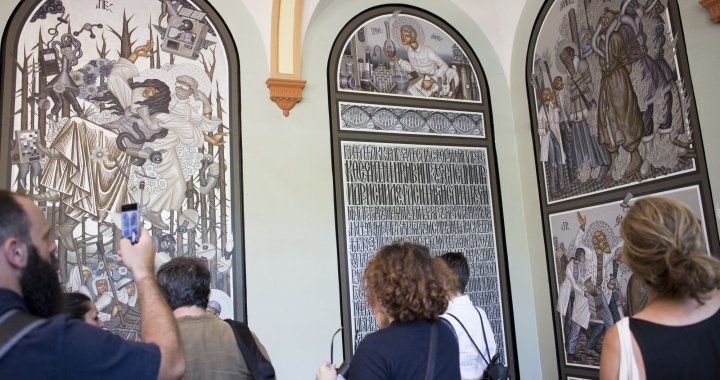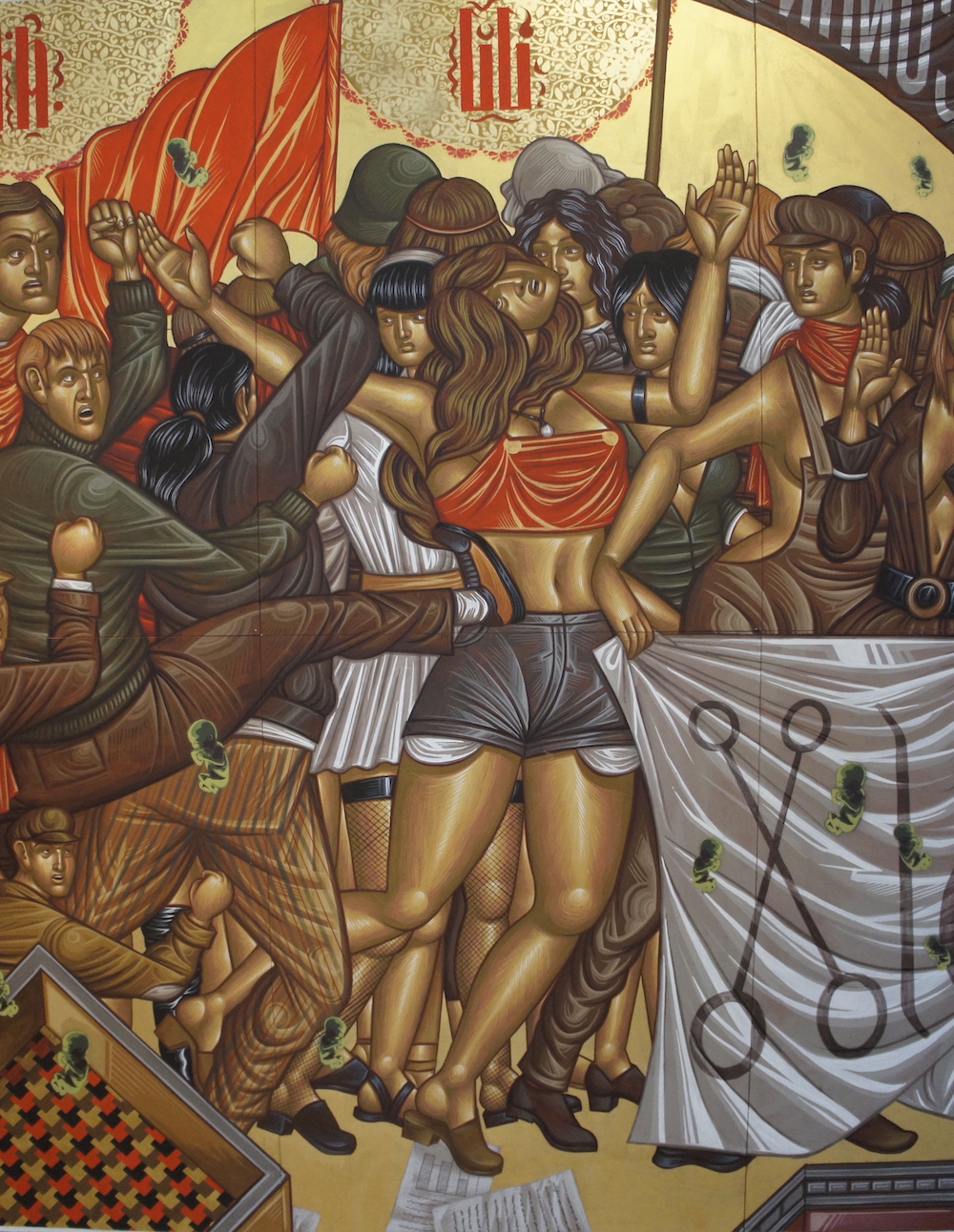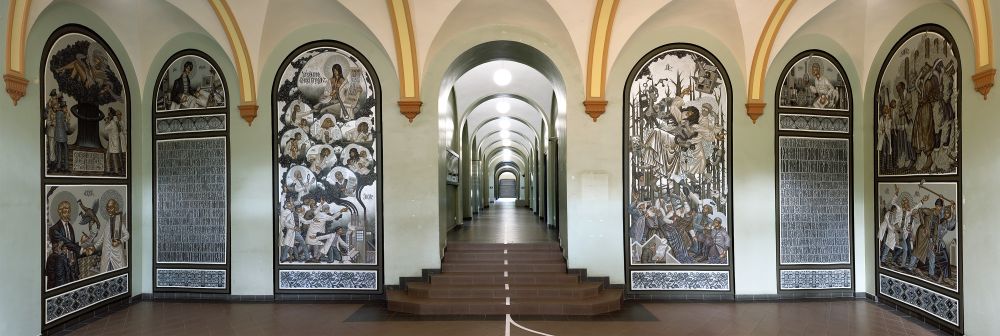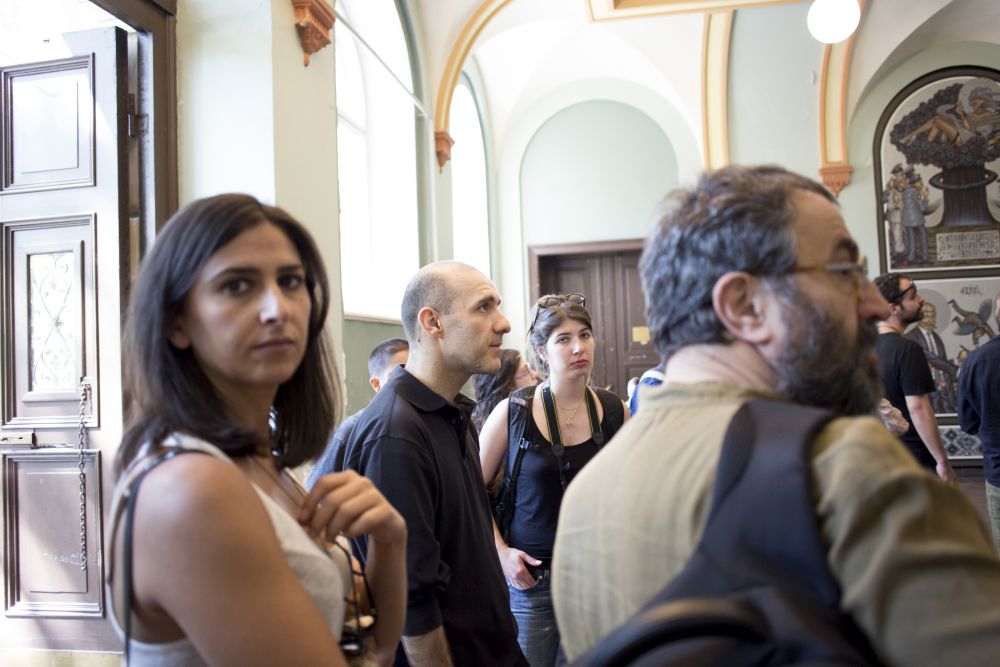
If I was a poet, I would write in Greek
RIBOCA1 participating artist Stelios Faitakis on the influence of street art and Byzantine icons on his painting
11/07/2018
The very first time I had the luck to view a work by Stelios Faitakis was just a year ago, at the Kassel documenta 14, in one of the galleries of the local Fridericianum museum ‒ on a white wall, a huge painting rich in gold. The first impression: it must be some magnificent unfamiliar icon. But what’s that? Instead of venerable wise elders and great martyrs, it depicts a throng of women under fluttering banners ‒ quite contemporary-looking women, at that, sporting shorts, miniskirts and leather boots; their hair dyed, their necks adorned with necklaces. They are confronted by a group of men; some of them are attacking the women. It is clearly a scene from the political life of today; is it women making a stand in defence of their right to control their own bodies? A demonstration transformed into a clash? Greek artist Stelios Faitakis sees life as a battle; in his works, however, this struggle seems to be unfolding as if somewhere in heaven ‒ in a mystical sky full of the golden and silver tones typical of the Cretan school of iconography, the successor of the Byzantine tradition of religious painting. In a sky that is also worldly: with their epic scope, the collisions and conflicts in his paintings are reminiscent of the class struggle in the 1930s Mexican wall paintings and Diego Rivera’s murals.

Stelios Faitakis. Fortunately absurdity is lost (but they hoped for much more) (2014). Fragment. Photo:
‘From the beginning, I chose to paint narrative pictures, like a still from a theatrical play: human characters in some environment doing some action—the simplest scenario possible, [with hidden meanings] as an extra for the more demanding eyes,’ says Stelios Faitakis in one of his rare interviews. Very few such have indeed been published: Stelios strives to keep any direct contacts with the press to a minimum, refuses to pose for photographs (‘No portraits!’) and prefers to answer journalists’ questions in writing.
I nevertheless managed to sit down with him for a talk during the first days of the Riga International Biennial of Contemporary Art in which he took part by invitation of his compatriot who has long earned international recognition, the curator Katerina Gregos. Back in Greece, Faitakis has been a well-known artist for many years now, first becoming famous as a street artist with the tag Bizarre. 2007 already saw him contribute to the Athens Biennial; in 2011, he showed at the Venice Biennale, in 2012 ‒ at the Kiev Biennial, and in 2016 painted a mural for an exhibition at the Palais de Tokyo in Paris (he was then shortlisted for the Jean-François Prat Prize). Alongside his interest in graffiti, which became his first art practice, Faitakis also received a classical art education in Athens, at the local School of Fine Art, where he enrolled despite the sceptical view taken by his parents. Mastering and reinventing the techniques traditional for his country helped him hone a very personal and inimitable style of his own. ‘I paint about Humanity and its relation to itself… so my characters flow in a golden world…. Simple, ordinary colours coexist with metallic/light reflecting colours... The gold refers to eternity, universal time.’

Elegy of May (2016) by Stelios Faitakis at Palais de Tokyo. Courtesy the artist and Rabouan Moussion Gallery. Photo: Aurelien Mole
‘The New Religion’, the painting by Faitakis on view in Riga through 28 October 2018 at the former building of the Faculty of Biology of the University of Latvia, the venue of one of the eight RIBOCA1 exhibitions, is dominated by more silvery tones that are surprisingly well complemented by the setting ‒ the actual building (also matching the metallic sculptural composition by Andris Vārpa depicting the structure of a molecule that greets everybody in the little square in front of the building since 2003). There many women again, only this time around they are clad in white lab coats instead of shorts (admittedly, not always covering their naked breasts). This is about science, about knowledge and about the fight for it that has ultimately lead to its idolisation ‒ according to the artist.


The New Religion by Stelios Faitakis at Faculty of Biology of the University of Latvia. Photo: Vladimir Svetlov
Stelios and I met up in front of the entrance and, to have our conversation, headed for the Pagalms café next door to the faculty building ‒ a place where you can sip your coffee while watching the neighbouring tennis court and the players relentlessly swinging their rackets. A man of medium height, dressed in a tracksuit, Stelios answered the questions unhurriedly, in short sentences, sometimes stopping for a pause and then closely observing the players ‒ as if they could at the moment prompt the most correct wording for his thought.
I used to play here in junior competitions. Did you play tennis as a child?
Yes, the tennis courts were nearby, across the street from where I used to live with my parents.
Was it in Athens? What was the neighbourhood?
Yes, it was the western part of Athens, a working-class neighbourhood.
Did you understand that when you were a child? Did you classify people as richer or poorer?
During my childhood I didn't. I am really more like one of those people who began to perceive many things much later than others. But once perceived, the things become very personal. In those years life was a little better for everyone around, and no one in particular complained.
And what about your parents, were they somehow involved with an artistic environment?
No, they worked at a factory where golden chains were made. And maybe that was when gold entered my life (laughs). I saw a lot of gold as a child. I used to admire its colour and its metallic shine.
Did your parents work on designing those chains?
No, no, my mother worked in an office and my father used to fasten the chains together.

Stelios Faitakis. Moloch. 2013. Mixed media on canvas. 245 x 193 cm
Was there a lot of graffiti in the neighbourhood where you lived?
Not really... Just some writing done by football club fans. But then two years before finishing school there was one guy who started painting graffiti. And that was really interesting to me because I liked the design of the letters and I was also drawing all the time. We didn’t know almost anything about graffiti at the time, maybe we just saw a little bit of it on TV. But when I saw something similar in real life, quite soon I wanted to do something like that too. I started doing it systematically, a couple of times a week. And finally I decided to get a fine arts degree.
I started in my neighbourhood, but after a couple of years I “spread" all around Athens.
What was the theme of your graffiti?
Very diverse things. And at the time I didn’t have my own “tag”. I wrote words that were interesting to me. For me graffiti was all about words.
You received a fine arts degree, but not only that…
In my second year at university I already started also doing martial arts. And those two things, drawing and martial arts have been with me my entire life. The practices in fighting have helped me to understand a lot of things in the art world, and not just there.
What particular practices attracted you in this field?
Ninjutsu and Judo. But I also did a little bit of boxing and Brazilian jiu-jitsu, Chinese internal arts etc. I have a black belt in Ninjutsu and I am trying to treat a bad injury I have and get it also in Judo.
Do you practice it every day?
Whenever possible, as you see right now I am wearing the training uniform. After we finish this interview I will go to the park for a training session. Here among the trees it feels absolutely amazing to train. It all gives me health, balance, and it gives me a lot of ideas.
Could we say that painting is also a type of fighting, fighting for your ideas?
But what is it fighting with?
With people’s unwillingness to think.. with the standards of thinking?
It’s hard to say. For me painting and art in general is not only about thinking.

Stelios Faitakis (in the middle) during the opening days of RIBOCA 1. Photo: Kristine Madjare
I am interested in how one influences the other. In the 20th century there were a lot of poets who boxed. And in Latvia I know a lot of artists who have been doing karate for many years.
Everything influences everything! I see it in that way. For me everything is the same. But of course this “everything” is made up of many fragments. And with some of the things from the surrounding environment you have an easier and more natural contact than with others. They are closer to you.
I am interested to know whether this influence of Byzantine Orthodox art is something that was also "closer to you"? How did you find your contact with this artistic tradition?
In the past I didn’t care much about it at all. I wasn’t interested in it and I even avoided it to some degree. But after my experience with graffiti I started to approach these things more and more. And now this artistic discipline is one of the most interesting in the world for me. In the past it helped create real world wonders.

Stelios Faitakis. Bouncer. 2013. Mixed media on paper. 28 x 19 cm
Did you have a kind of enlightenment at some point, a concrete understand that “yes, this is mine”?
It was more related to the technical side rather than a theoretical one. I started drawing darker layers at first, then slowly lighter and lighter ones. The same way it was done in the Byzantine tradition. At the same time, I was interested in religious painting of other countries. And at some point I understood that it was the right thing to do to follow the course of the artistic discipline that had arisen and was formed in my homeland, on my land. If I were a poet, I would write in Greek. I would not write in English, hoping that I would be understood by the maximum number of people. That's how I began to paint in a Greek manner, which has more than fifteen centuries worth of history.
That type of painting had a specific function in temples, it was designed to cause a special kind of sensation in the congregation. Are you trying to evoke something similar in your audience?
Of course I want to evoke emotions, maybe not such specific ones like in a church, but still emotions. I don’t want to make people understand my art. 90 percent of the affect is connected with feelings and maybe only 10% with understanding.
It sounds like a paradox to me, because usually your works are saturated with information. They are always connected to some sort of context. And additionally the works themselves have a lot text in them…
I write the texts on my paintings in such a way that in the end even I can’t read them. I code them… If you give me one of my old paintings with text, I wouldn’t be able to read it. The information you mention sometimes is complex and doesn’t guide to a specific meaning, clear and same for every viewer.

The New Religion by Stelios Faitakis. Fragment. Photo: Vladimir Svetlov
So text plays a symbolic role here?
Yes, symbolic. And that is the encryption, a kind of inaccessibility. Just the images of letters are enough to feel something. They do not need to be understood. Once I was in Paris at a large exhibition of old Chinese art, and there was a huge piece of paper filled with Chinese calligraphy. I did not understand anything there, but the actual visual effect was enough for me.
When I look at your works, I feel that they return a dimension that had disappeared back into our life. There is so much happening around us, so many news, that they all seem small to us. But you return the feeling of grandness and importance to the things that you draw…
Yes, I agree. I chose that position and it seems to be working.
You chose the theme of science and its role in our society for your frescoes in the former building of the Faculty of Biology. Was it somehow inspired by the place itself, or have you been nurturing this idea for a long time?
I chose this idea some time ago and I think that I will continue to explore it for the next couple of years. And when I saw the building I understood that it is possible to present a rather large and “thorough” statement on the topic. This is an ideal space to start a big series.

The New Religion by Stelios Faitakis. Fragment. Photo: Vladimir Svetlov
You named those works “New Religion”…
Yes, because I think that science is really the “new religion” of our society. Everyone believes in it. But I think you shouldn’t believe in everything, and you can’t go without having a critical eye. I don’t think that scientists know everything or that they know better about what we should do in every field of our lives and how. They can’t know everything about the universe because the core of science is logic. And logic has borders. This means that acquiring knowledge with the help of logic is finite.
Many of the scientists depicted in the Riga works are women.
Yes, that is important to me. It is related to the fact that, as far as I know, the role of female scientists was huge here during the times when in other parts of Europe it wasn’t as common. Here they play the role of some kind of saints…saints of Science.
But if we want to understand the world and at the same time we have to look at science with a critical eye, what can help us in this situation?
Intuition. A mix of logic and intuition. A balance between them. And I personally find intuition to be more important.

The New Religion by Stelios Faitakis. Fragment. Photo: Vladimir Svetlov
Have you made intuitive decisions in the course of your career?
Many times. And many times it worked. And anyway intuition develops over time.
Can you train it?
Yes. You can cultivate it and make it more “accurate”. Although you cannot be one hundred percent confident in it. And in this area you can find teachers and methods. These are practices in breathing and meditation.
A sort of mix between physical and spiritual practices…
Yes.
And how do representatives of religious world views look at your paintings?
So far I have not heard anything critical myself. But certainly some people have an aversion to them. There is nothing I can do to help. It's a pity when someone actively does not like what I do, but I do what I must and I'm moving forward.
And if representatives of Greek Orthodoxy called you to decorate a new church with your murals, would you do it?
I would say that they should find someone else who would fit them better. I draw my ideas, not canonical subjects. I like a lot of things in Orthodoxy but I’m not its follower, same as I am not a follower of any other religion.
But if they told you that you can draw your own chosen stories, not biblical motifs?
Then why do it in the church? In a place where completely fixed rituals get repeated? No, you should not do this.

Stelios Faitakis. Fortunately Absurdity is Lost (Part II: Not quite dead). 2014. Latex, acrylic and spray on wood, 300 x 231 cm
There are quite a lot of people in our time who consider themselves religious but outside of any certain confession. Many of them, let's say, believe that in our reality there is a layer that we do not comprehend…
Yes, I agree with them. And my pictures are also religious in their own way. As I said hey are about feelings, not understanding.
Religious in what sense?
The fact that you can only feel some truth only sometimes. The truth that I believe in cannot be expressed in words, whatever these words may be. This world was created in such a way that people are constantly in conflict. And there is no universal solution to this. Perhaps the world will change, but in a completely opposite direction than the one the revolutionaries and politicians call to. Any given political system is imperfect. Changes must come from within. Otherwise, we will always win something on one field and lose on the other.